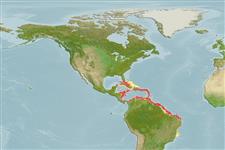>
Eupercaria/misc (Various families in series Eupercaria) >
Lutjanidae (Snappers) > Lutjaninae
Etymology: Lutjanus: Malay, ikan lutjan, name of a fish.
More on author: Poey.
Environment: milieu / climate zone / depth range / distribution range
Ecologia
marinhas demersal; intervalo de profundidade 26 - 340 m (Ref. 9626), usually 70 - 120 m (Ref. 55). Tropical; 25°N - 19°S, 87°W - 35°W (Ref. 54572)
Western Atlantic: throughout most of the Caribbean Sea from Cuba southward to northeastern Brazil. Frequently confused with Lutjanus campechanus. Also referred to as Lutjanus aya by past authors, but Rivas (Ref. 6409) proved that Bodianus aya Bloch, 1790 is not a lutjanid, but probably a sciaenid.
Length at first maturity / Tamanho / Peso / Idade
Maturity: Lm 43.0, range 42 - ? cm
Max length : 100.0 cm TL macho/indeterminado; (Ref. 55); common length : 65.0 cm TL macho/indeterminado; (Ref. 55); peso máx. Publicado: 10.0 kg (Ref. 5217); Idade máx. registada: 18 anos (Ref. 55)
Espinhos dorsais (total) : 10; Raios dorsais moles (total) : 14; Espinhos anais: 3; Raios anais moles: 8 - 9. Head short, its dorsal profile somewhat rounded behind eye. Snout short and blunt. Eye large. Preopercular notch and knob weak. Pectoral fins long, reaching level of anus. Scale rows on back rising obliquely above lateral line. Back and upper side deep red; lower sides and belly rosy, with a silvery sheen; the fins mainly red. A small spot is sometimes on the lateral line below the anterior portion of the dorsal fin rays. Young with a rounded black spot on upper side below anterior dorsal soft rays, disappearing with growth.
Adults inhabit rocky areas. They feed mainly on fishes, shrimps, crabs, cephalopods and planktonic items.
Allen, G.R., 1985. FAO Species Catalogue. Vol. 6. Snappers of the world. An annotated and illustrated catalogue of lutjanid species known to date. FAO Fish. Synop. 125(6):208 p. Rome: FAO. (Ref. 55)
Categoria na Lista Vermelha da IUCN (Ref. 130435: Version 2024-1)
Ameaça para o homem
Reports of ciguatera poisoning (Ref. 31172)
Utilização humana
Pescarias: espécies comerciais
Ferramentas
Relatórios especiais
Descarregue XML
Fontes da internet
Estimates based on models
Preferred temperature (Ref.
123201): 21.2 - 26.5, mean 24.8 °C (based on 38 cells).
Phylogenetic diversity index (Ref.
82804): PD
50 = 0.5000 [Uniqueness, from 0.5 = low to 2.0 = high].
Bayesian length-weight: a=0.01479 (0.01294 - 0.01691), b=2.97 (2.94 - 3.00), in cm total length, based on LWR estimates for this species (Ref.
93245).
Nível Trófico (Ref.
69278): 3.6 ±0.6 se; based on diet studies.
Resiliência (Ref.
120179): Baixo, tempo mínimo de duplicação da população 4,5 - 14 anos (K=0.09-0.12; tm=5.5; tmax=18; Fec=2,693,173 (mean)).
Prior r = 0.48, 95% CL = 0.32 - 0.72, Based on 3 data-limited stock assessments.
Fishing Vulnerability (Ref.
59153): High vulnerability (60 of 100).
Climate Vulnerability (Ref.
125649): High to very high vulnerability (75 of 100).
Nutrients (Ref.
124155): Calcium = 55 [29, 111] mg/100g; Iron = 0.512 [0.286, 1.003] mg/100g; Protein = 17.6 [16.0, 19.1] %; Omega3 = 0.209 [0.119, 0.358] g/100g; Selenium = 161 [77, 341] μg/100g; VitaminA = 25.5 [4.6, 118.8] μg/100g; Zinc = 0.399 [0.255, 0.618] mg/100g (wet weight); based on
nutrient studies.
